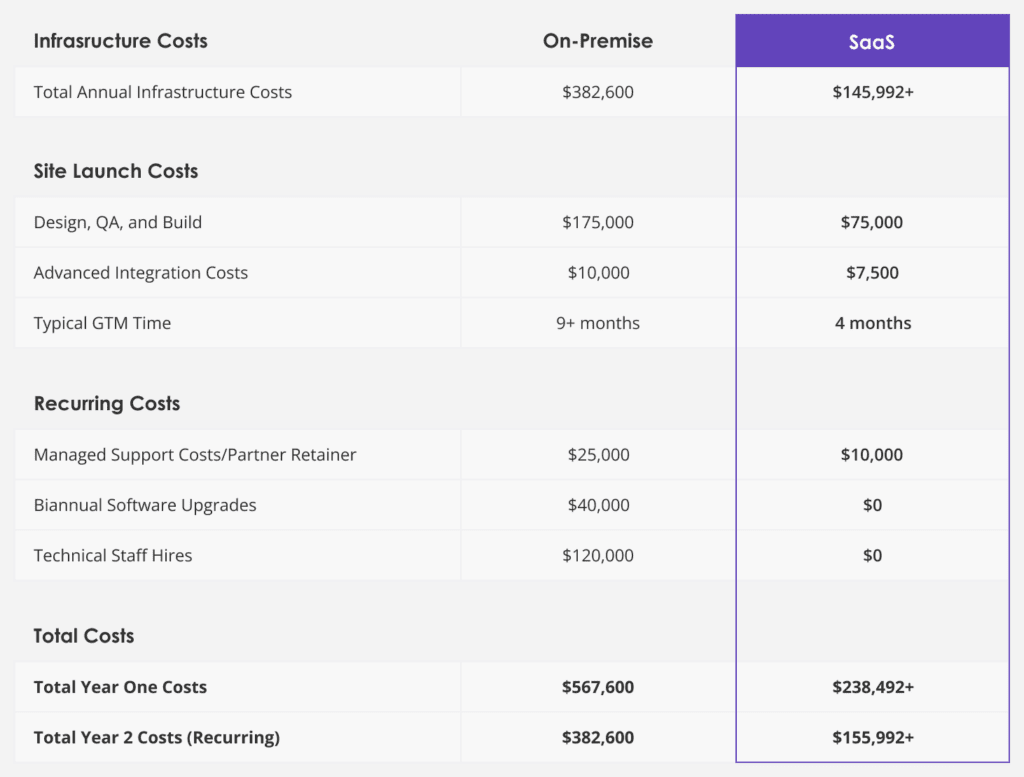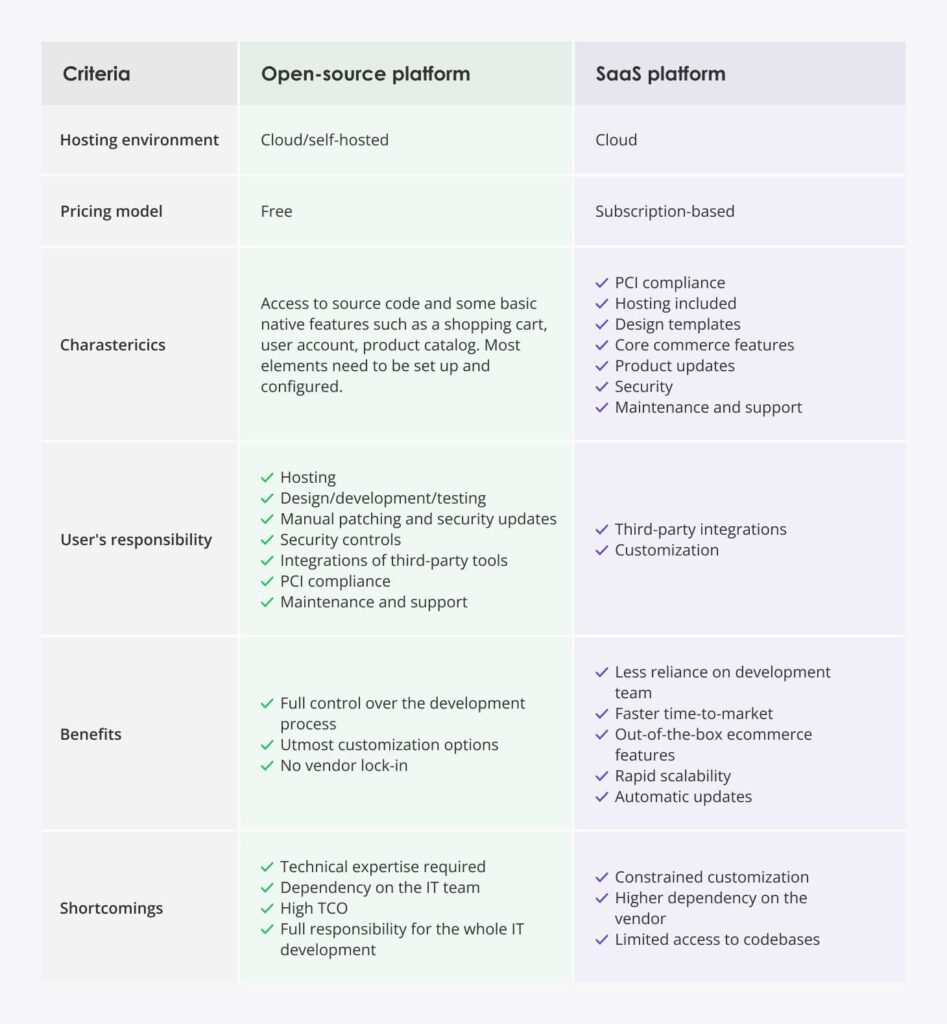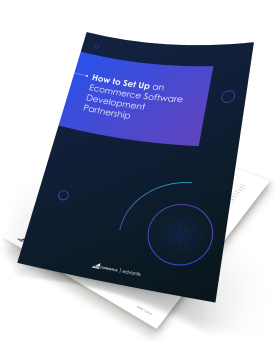
You keep growing your traffic and sales, but unplanned downtimes halt your progress. Conversion rates could have been better. New feature releases take ages — and adding new functionality is unfeasible because of certain legacy architecture choices. Despite a growing IT team, Software Engineers are overworking.
When the above operational mode becomes your routine, you know it’s time to replatform. Ecommerce replatforming is a work-intensive, time-consuming, and costly process. However, it’s often the only right action to achieve further growth.
5 Signs You Have Outgrown Your Current Ecommerce Platform
Change is hard to accept. Especially the change of replatforming the large store with enormous data and millions of users. According to the 2022 Ecommerce Platforms Report, 42% of retailers use the same ecommerce platform for more than five years.
But you know there’s a point of no return when the issues with your current platform outweigh the fear of replatforming. Here are five signs it might be your case.
Sign 1. Difficulties with Supporting Omnichannel Retail
Omnichannel has become the primary way consumers shop: 75% now research and purchase goods in-store and online. Also, 20% shop via mobile apps, and 11% buy from social media.
Retail brands must provide a consistent and delightful customer experience (CX) across all touchpoints to stay ahead of the competition. After all, 46% of customers want to switch a channel without restarting their conversation with a brand.
Yet, legacy ecommerce platforms often have limited omnichannel ecommerce capabilities. Because of that, you can face:
- Issues with integrating inventory management across channels
- Lack of unified customer view across all channels
- Data silos when it comes to collecting KPIs across channels
- Inconsistent design and branding experiences
All of the above factors hinder your growth.
Sign 2. Costly and Time-Consuming Customization
Consumers expect delightful and unique experiences, especially from larger retailers. However, not all ecommerce platforms allow brands to:
- Create dynamic landing pages for every marketing campaign and region.
- Implement a complex content architecture for different channels.
- Adjust online store design without calling the IT department each time.
- Deploy innovative features — BNPL at check-out, virtual advisors, etc. — without significant architecture changes.
- Integrate user-generated content, personalized up-sells or cross-sells, and other revenue-generating features easily.
Many perceive open-source ecommerce platforms as more customizable. That’s true, but you’ll need to develop new features from scratch, which means higher development costs.
Open SaaS ecommerce platforms, in turn, provide you with a “base” — core commerce features — and easy customization or integration options through pre-made APIs. This is more cost-effective.
For instance, if you opt for headless commerce architecture, you can add custom front-ends to your store faster (often without much dependency on the IT teams).
Sign 3. Mounting Tech Debt
Legacy codebase hampers your performance metrics, which, in turn, hurts the customer experience. However, this does not happen immediately.
Here’s how tech debt grows. First, your development team opts for “workarounds” to reduce development time. Subpar coding decisions pile up and progressively create performance lags. No regular version updates are made (especially if these aren’t automated on your ecommerce platform). Also, core platform updates can often break poor coding decisions made earlier.
Eventually, a bloated ecommerce platform code base consumes significant resources. When this is the case, you have to deal with:
- Scalability issues
- More security risks
- Performance lags under peak traffic
- Slow page loading time
- Difficulties with integrating third-party tools
When discussing their decision to replatform from Magento to BigCommerce, Kintec noted that the Magento store couldn’t tolerate high loads. “We would be preparing for Black Friday; we would have all of it up there, and the site would crash.” At the same time, they struggled to adopt effective omnichannel operations.
To mitigate this, the retailer moved to BigCommerce. Post-replatforming, the company recorded a 42% decrease in cost per click and a 111% increase in orders — plus, no more unplanned downtime during busy seasons.
Sign 4. Limited Ecommerce Analytics
Understanding your customers’ behavior is critical to exceptional CX. Most ecommerce platforms provide analytics tools either out of the box or as third-party extensions. But that’s about it.
Your company might want to run more advanced data modeling scenarios at some point. For example, calculate customer lifetime value across channels, extrapolate future demand for specific product categories, or develop the optimal warranty offer. Such use cases require a robust data governance process and data science expertise.
In other words, you’ll need to build a secure cloud platform for collecting data for analysis and then developing the various algorithms. Many ecommerce platforms make it hard to de-silos your data — and don’t have pre-made APIs you can “plug” into your analytics platform to obtain the necessary intel.
Sign 5. Rising TCO
On average, developers spend 33% of their time maintaining legacy systems. Your team spends more time keeping old code running and tackling technical debt instead of building new commerce functionality.
Many legacy systems limit the ability to extend your online store because of sub-optimal code dependencies. Upgrades or scaling may result in unexpected defects or system failures. This leads to a Groundhog Day of unplanned maintenance.
Consequently, you’ll need more hands to handle the work — and your total cost of ownership also rises.
Let’s see the difference in TCO between on-premise and SaaS platforms on the examples from BigCommerce’s TCO calculator. With 100 thousand monthly visits, six peak hours, 180 average hourly visitors, and 100 million yearly revenue, here’s how a company’s TCO will vary:

Source: BigCommerce Total Cost of Ownership Calculator
How to Build a Business Case for Ecommerce Replatforming
In short, an effective replatforming strategy boils down to four elements:
- Selecting the new target platform
- Data migration
- New integrations set up
- UX/UI adjustments
For each element of replatforming, you will need lists of system specifications, an assessment of your current ecosystem, and an audit of your operations.
But how to put it all together and where to start? We’ve outlined steps to follow when creating your business case and initiating the ecommerce replatforming process.
1. Chart Your Baseline
The right platform should meet your needs and grow with you as you go. However, to choose the one, you must know where you stand. What are the shortcomings of your present platform? Where is your website lacking in performance?
To understand what elements you currently lack, use the following framework:
- Performance-test your online store: Measure your pages’ speed, load tolerance, and downtime. Note the current website KPIs to compare them with your future results.
- Talk to stakeholders: Gather feedback from your teams, management department, and even customers to learn what additional features/experiences they need or what issues they experience.
- Prioritize must-have characteristics and features: Use the Eisenhower matrix for prioritizing the feature list:
- Urgent and important: the most high-priority features; customers won’t buy the product without them.
- Important but not urgent: a feature that will later shift into a high-priority section. You can delay its development for now.
- Urgent but not important: features that don’t impact the customer journey but are important for a business (e.g., analytics). You might consider adding them during later stages of development.
- Neither urgent nor important: features that do not deliver value, so you might consider erasing them from plans or delegating them to other teams.
By capturing your starting point, you can form short- and long-term goals for your replatforming process.
If you don’t know how to go about this and other steps, find a technology partner that offers discovery sessions.
During a project discovery, you and your vendor develop a vision for your software product, define all the requirements, create a preliminary roadmap, and identify the risks of your replatforming project. As a result, you and your technical partner will have a shared understanding of what needs to be done to accomplish your replatforming goals.
2. Collect the Initial List of Requirements
Interview all the key stakeholders – IT, sales, and operations teams – to make a list of functional and non-functional requirements.
A good approach is to audit every element of your operations — from overall UX/UI design and content management to more specific platform architecture issues.
Here are some ideas for questions you can ask:
- IT audit: Which integrations are already present, and which do you need? What issues do your development teams face? What improvements do you want to see in the new platform? Does the current platform handle traffic spikes well?
- User experience audit: What are the gaps in your user flows? Do you need extra features to support your sales funnel? What do customers like/dislike about your store?
- Marketing audit: Do you need technical support to run sales and discount campaigns? What are our mobile traffic conversion rates? Can you integrate your blog with the product catalog?
Technical requirements gathering aims to analyze stakeholder input and construct self-contained, concise, feasible, and testable conditions. Ideally, they must be tailored to your needs and easily understandable to all your teams.
3. Compare Different Ecommerce Platforms
Now it goes down to choosing an ecommerce platform that ticks most of your requirements. You have two options to consider: open-source platforms and SaaS platforms.

The option that also deserves attention is the headless commerce platform – a subtype of SaaS. Headless is a number one trend in retail, according to 52% of digital agencies and 46% of merchants.
With headless, you will handle the user-facing components of the store separately from the backend and transactional functions. It will allow you to alter the appearance of their website without having to code.
In a world of dynamic user needs where you might need a new advertising campaign every week, Headless allows businesses to remain afloat and even row the retail boat faster than their competitors.
4. Decide Who Will Handle the Replatforming Project
You have created a list of requirements and selected an ecommerce platform, so now you can assemble a replatforming team. Ideally, you need people who are familiar with:
- Selected ecommerce platform
- Ecommerce data migration
- System Integrations
- UI/UX design
But what if you don’t have the right people to complete such a process in-house? Consider a technology partner in this case.
Edvantis is a BigCommerce certified partner. We have two service models for replatforming projects:
- Dedicated Team is a cross-functional unit we set up for your project. Together, we will share management responsibility for the team.
- Staff Augmentation is a service model where we help you hire people with the missing skillsets for your replatforming project, whom you manage directly.
Moving Forward with Replatforming
Replatforming isn’t just about lower maintenance and less load on IT teams. Your first and foremost goal is to improve customer satisfaction and boost your sales. After all, 77% of consumers say that a good customer experience would influence them to spend more money with the brand.
To remain an ecommerce top performer, you must make bolder, more innovative, and better decisions than your competitors. Replatforming is often one of them.
Contact Edvantis to receive a further consultation on replatfoming your ecommerce operations to BigCommerce.







